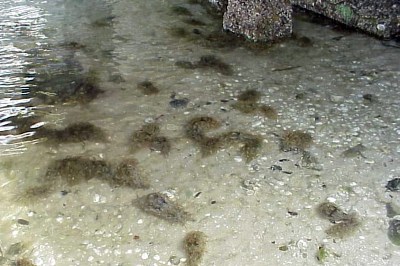
Mass mortality
PHOTO
Mass mortality of Bursatella leachi, Florida, Gulf of Mexico, February 2001. Photo: Dana Mueller.
At times, large numbers of Sea Slugs, usually Sea Hares, are found dead and dying in large numbers, often in the shallow intertidal. While it is possible this phenomenon could be the result of pollution, it is more likely that natural causes are the cause.
Sea Hares are often found aggregated in large numbers, often stranded and dying at low tide. Have a look at the message about the small Sea Hare Stylocheilus striatus, where I discuss some of the ideas we have about these mass deaths in Sea Hares. Basically it seems that sometimes, when conditions are very favourable, large numbers of juveniles settle out of the plankton and grow rapidly to maturity (a bit like the 'baby boomer' generation after the Second World War). However at the inevitable dying end of the life cycle they all tend to die at the same time. This does not mean to say that there are not outside events which hasten the end. If these large populations coincide with periods of hot weather, relatively warm water and very low tides, death of intertidal animals, especially on broad sandflats, is often inevitable. At low tide exposed animals can be overheated and desiccated, and the returning sea water as the tide turns, rather then providing relief, brings water which has been heated and deoxgenated as it runs in over hot sandflats. Alternatively a period of rough weather and storms can dislodge and wash large numbers on to the shore. In these cases I am afraid there is nothing much we can do. It is an unusual but natural phenomenon. For more general information on Sea Hares have look at the list of 'Sea Hare' topics in the GENERAL TOPICS index.
See messages and discussion below.
See also the following messages elswhere in the Forum:
• Sea Hare mating chains
•on Mass mortality in Aplysia californica in Baja California.
•on Population Fluctuations.
•on Mass mortality of Aplysia dactylomela in Florida.
•on Adult dispersal in Stylocheilus striatus in Hawaii
•on Swarming in Stylocheilus striatus in Hawaii (1).
•on Swarming in Stylocheilus striatus in Hawaii (2).
•on Swarming in Stylocheilus striatus in Hawaii (3).
•on Swarming in Stylocheilus striatus in Caribbean.
•on Swarming in Stylocheilus striatus in Turks & Caicos Ids
•on Swarming in Stylocheilus striatus in Barbados
•on Mass mortality in Aplysia brasiliana.
•on swarming in Aplysia fasciata.
•on swarming in Aplysia gigantea.
•many messages in February - March 2001 on Mass mortality in Aplysia morio in Florida.
•4 messages on Mass mortality in Bursatella leachi in Auckland, New Zealand, May 2000.
•3 messages on Mass mortality in Bursatella leachi in Florida.
• Breeding aggregation of Bursatella leachi in Trinidad, West Indies.
•message on egg laying and Mass mortality in Bulla quoyii in New Zealand.
Rudman, W.B., 2001 (March 22) Mass mortality. [In] Sea Slug Forum. Australian Museum, Sydney. Available from http://www.seaslugforum.net/factsheet/massmort
Related messages
-
Stranding of Sea Hares in New South Wales
From: Brenda Harris, July 2, 2007 -
Mass Stranding of Sea Hares in nthn New South Wales
From: Belinda Allman , February 14, 2007 -
Re: Mass Stranding of Sea Hares in nthn New South Wales
From: Inger Vandyke, January 16, 2007 -
Mass Stranding of Sea Hares in nthn New South Wales
From: Michael Hill, January 15, 2007 -
Re: Mass mortality of Aplysia californica
From: Ellen Hall, September 5, 2005 -
Ebro Delta, Spain - Large Sea Hares
From: Jorge Jimenez, August 20, 2005 -
Migration inshore of Aplysia punctata
From: Dr. Stephen Hoskins, June 11, 2003 -
Bloom of Aplysia in Portugal
From: Manuel Malaquias, September 17, 2002 -
Swarming in Stylocheilus striata
From: John Hoover, April 7, 2002 -
Swarming behaviour in Aplysia
From: Dr. Stephen Hoskins., April 3, 2002 -
Re: Sea Hares - mass mortality
From: Anne DuPont, September 28, 1999 -
Re: Sea Hares - mass mortality
From: Wayne Ellis, September 10, 1999 -
Sea Hares - mass mortality
From: Anne DuPont, September 9, 1999
